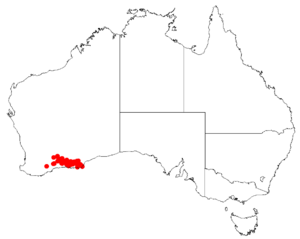Boronia baeckeacea facts for kids
Quick facts for kids Narrow-leaved boronia |
|
|---|---|
 |
|
| Boronia baeckeacea in the Australian National Botanic Gardens | |
| Scientific classification | |
 |
|
| Occurrence data from Australasian Virtual Herbarium |
Boronia baeckeacea is a special plant that belongs to the citrus family, called Rutaceae. It grows only in certain parts of Australia. This plant is a thin or sprawling bush. It has simple or three-part leaves. Its pretty flowers are pink and white with four petals. You can find it mainly in the southwest of Western Australia.
Contents
What Does It Look Like?
Boronia baeckeacea is a thin or sprawling bush. It usually grows to be about 0.2 to 1 meter (about 0.7 to 3.3 feet) tall. Its leaves can be simple, meaning just one part, and are about 2 to 7 millimeters long. Some plants have "trifoliate" leaves, which means they have three parts. These leaves are about 4 to 7 millimeters wide.
This plant produces lovely pink and white flowers. Each flower has four sepals and four petals. You can see these flowers blooming for most of the year, from March all the way to December.
How It Got Its Name
The plant Boronia baeckeacea was first officially described in 1863. A scientist named Ferdinand von Mueller gave it its name. He published his description in a book called Fragmenta phytographiae Australiae.
Mueller didn't say exactly why he chose the name baeckeacea. However, he did mention that the plant looked similar to some species of another plant called Baeckea. This is how many plants get their scientific names, often based on their appearance or who discovered them.
Different Types of Boronia baeckeacea
Just like there can be different types of apples, there are two main types, or subspecies, of Boronia baeckeacea:
- The Common Boronia baeckeacea (subsp. baeckeacea): This type has simple, upright leaves. The leaves are almost round and are about 2 to 3 millimeters long. You can find this subspecies growing in many different places. It grows between a town called Pingrup and a place called Mount Ragged, which is in the Cape Arid National Park.
- The Spreading Boronia baeckeacea (subsp. patula): This type has leaves that spread out more. Its leaves can be simple or trifoliate (three-parted). They are broadly oval or egg-shaped and are about 4 to 7 millimeters long. This subspecies grows in a type of bushland called mallee. You can find it near Mount Ney and Mount Heywood, which are northeast of Esperance.
Protecting This Plant
It's important to know if plants are safe or if they need help to survive. The government of Western Australia's Department of Parks and Wildlife keeps track of this.
- The common subspecies, baeckeacea, is considered "not threatened." This means there are enough of these plants, and they are not currently in danger.
- However, the subspecies patula is listed as "Priority One." This means it is a special concern. It is only found in one or a few places, and these locations might be at risk. Because of this, it needs extra protection to make sure it doesn't disappear.

